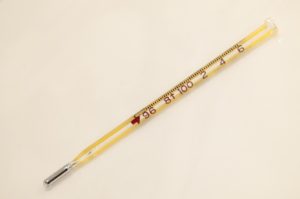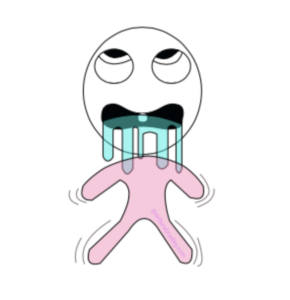
Seeing your child have a febrile seizure is one of the scariest things you can experience. Most parents who witness them don’t know what’s going on because they didn’t have any previous warning that this could happen.
“Now I know how common they are, but it’s not widely known or talked about. Even all my family and friends that were with us on the trip, we were 6 adults there, and none of us knew what was happening. So, yeah, I think just not knowing what it was and not knowing how to help him was the hardest part.”
-Rachel, mother of William.
So what’s a febrile seizure?
Febrile seizures are convulsions created by fever. They are common and happen in 2 to 5 percent of children between the age of 6 months to 5 years. Often the seizure is the first sign of your baby’s fever, so they seemingly come out of nowhere.
How to recognize a febrile seizure?
One day, randomly, the child has a fever and subsequent simple febrile seizure:
- The child loses consciousness and does not respond to your voice.
- The eyes glaze over or roll into the back of the head.
- The color of the face changes and become pale or blue.
- The body stiffens or convulses.
This graphic represents what it looks like:
 As you can easily see, a febrile seizure looks alarming, and you may panic because you don’t know what you can do to help.
As you can easily see, a febrile seizure looks alarming, and you may panic because you don’t know what you can do to help.
Here’s what to do to stay focused on the things you can control, even if you’re the only adult present at the moment.
As soon as you notice the seizure
- Try to remain calm. Even though your child seems in tremendous pain, remember that what you see is not what they feel.
- Yell for help to any person nearby. It’s always good to have assistance in a situation like this, if available.
- Check the time, if easily accessible, so you know how long the seizure lasts.
- Put your child down in a safe area onto their side. It is called the recovery position. It will keep the airway clear and open.
- Immediately call an ambulance, especially if the seizure lasts more than 5 minutes, or if you are concerned with anything (seizure is not fully recovered, breathing is abnormal, or if they have been injured). If you are with somebody, have them call the emergency hotline while you take care of the child. If you are by yourself, call the emergency hotline once your child is safely on their side (Dial in the United-States or Canada: 911, Australia: 000, United Kingdom: 112 or 999).
- While waiting for the ambulance, stay next to your child and protect them from injury, especially on their head. If your child vomits or foams at the mouth, clear it out away from the airway. Do not put anything inside their mouth; they will NOT swallow their tongue.
- If you have one, administer rescue medication according to your doctor’s prescription.
- Do not restrain your child, but loosen any tight clothing/diapers.
- Seizures are often accompanied by uncontrollable twitching of the body. In the event this occurs, check whether one or both sides of their body moves. If one side jerks more than the other, try to remember which one and tell your practitioner.
- After the seizure stops, keep your child on their side.
- After the seizure, the child may be very sleepy, which is nerve-wracking for parents. Stay calm, allow them to sleep, and wake them up gradually.
- ALWAYS inform your regular doctor about what happened, even after a very brief episode.
Do not
- Do not restrain your child during a convulsion.
- Do not put anything in their mouth, including your fingers; your child will not choke or swallow their tongue.
- Do not put a child who is convulsing into a bath.
On the phone with the emergency hotline
- Stay calm, collected, and speak clearly
- Give your phone number, name, and exact address including floor or intercom code
- Describe what is happening:
- What symptoms alerted you?
- What time did the seizure begin?
- Describe the episode: loss of consciousness – movements of your child’s eyes (e.g. rolled back) – Shaking? Tensing?
- Did this affect the whole body or only one part of the body?
- What is the color of the child? (pale? blue? normal?)
- Inform the operator of any medications the child is on / any diseases the child has.
- DO NOT hang up until they tell you to do so.
You can find a printable version of this guide at www.drflorabradley.com.
How you may feel afterward
A doctor will look for the infection that caused the fever. If your doctor can’t see any signs of an infection, they may take a urine sample or blood test. The doctor might also send your child to the hospital for a short while, to keep an eye on them.
You’ll feel a sharp contrast between what you have experienced and the nonchalant medical evaluation from the hospital staff. This is normal because febrile seizures are pretty common (2 to 5% of children in the United States), and are usually harmless. The medical staff is trained to focus on more critical patients. However, their reaction may frustrate you, if the situation you observed appeared more threatening than it actually was.
At that point, you’ll probably feel confused, maybe a little frantic, or just plain anxious about this happening again. Keep in mind that plenty of parents have gone through similar battles. You don’t have to take this on by yourself. Some parents are content with the harmless nature of febrile seizures while others require additional help and/or counseling.
The various coping skills available to you may help combat the mental stress of observing a febrile seizure but will not necessarily prevent one. Talk to your doctor to discuss which method is right for you.
With time, good information, and stress relief techniques you’ll be able to restore a sense of normalcy to your family.
DISCLAIMER
This information is about febrile seizures. This information does not pertain to parents of children with previous neurologic insults, known central nervous system abnormalities, or history of afebrile seizures.
I’ve brought together the best and most up-to-date research about febrile seizures. This information, however, does not replace medical advice. You can use my information to talk to your doctor, and, if you have a medical problem, please see your doctor.
REFERENCES
- Subcommittee on Febrile Seizures, American Academy of Pediatrics. Neurodiagnostic evaluation of the child with a simple febrile seizure. Pediatrics. 2011;127:389–394.
- Nikhil Patel, Dipak Ram, Nina Swiderska, Leena D Mewasingh, Richard W Newton, Martin Offringa. Febrile seizures. BMJ. 2015; Aug 18;351:h4240
___
 Flora Bradley, MD, is a published pediatrician from France. She studies and understands the stress that parents experience after observing their child’s febrile seizure. She currently works and lives in California with her family.
Flora Bradley, MD, is a published pediatrician from France. She studies and understands the stress that parents experience after observing their child’s febrile seizure. She currently works and lives in California with her family.
She recently started a website dedicated on febrile seizures and parental stress: www.drflorabradley.com.
The following mothers gave invaluable feedbacks in the creation of this guide: Bilim Atli Veltim, Rachel Harpley, Taryn Hobby, Crystal Mohan, Angélique Moynier, Yael Tesler.
Interested in guest posting for us? We can’t wait to read what you’ve got to say! Get started by visiting our Guest Post Submission page.
Editor’s Note: This article originally published on October 26, 2017, and was lightly edited prior to republishing.






















I too suffered from febrile seizures. I was since diagnosed with tonic clinic seizures.
I too suffered from febrile seizures. I was diagnosed with tonic clonic seizures.